Papers by Dr. Muhammad F O R H A D Ali
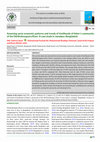
Archives of agriculture and environmental science, Dec 25, 2022
The current study was assessed the socioeconomic patterns and trends of livelihoods of the Old Br... more The current study was assessed the socioeconomic patterns and trends of livelihoods of the Old Brahmaputra River fisher's community in the Jamalpur district from July 2021 to June 2022. The livelihood status was analyzed regarding age distribution, family size and composition, religion, marital status, education levels, living standards, diseases, healthcare, electricity, sanitation, drinking water facilities, fishing, and employment status. Most fishermen (45.76%) were 35-50 years old, with 91.53% were Muslim. The average family size for a fisher was medium, with 5-7 members. 33.9% were illiterate, 37.29% could only sign, 20.34% finished primary school, and 8.47% completed SSC. Most fishermen had tin roofs 59.32%, straw roofs 22.03%, semi-paka houses 11.87%, and paka houses 6.78%. Approximately 45.76% of fishers relied on village doctors, 33.9% on the Upazila Health Complex, 8.47% on Kobiraj, and 11.87% on MBBS doctors. Approximately 93.22% of fishermen's homes were equipped with electricity. Fishing was the main activity for more than 57.63% of the fishers. Fishermen have suggested specific management strategies to halt the trend of decreasing fish catches and increasing fish production. These include restricting the use of harmful gear, prohibiting the catching of juvenile fish, creating fish sanctuaries, and releasing fish fry.

International journal of fisheries and aquatic research, Sep 1, 2017
As Bangladesh is endowed with around 250 freshwater fish species, the etymological analysis of cu... more As Bangladesh is endowed with around 250 freshwater fish species, the etymological analysis of currently used fish scientific names may have interesting motifs in various scientific fields. It is very hard to find out the meanings of scientific names of fishes due to lack of recognized identifying books and literatures. Additionally, systematic nomenclature will be not recognized and understood without having a clear knowledge about the origin of a word. Though some of these words have been deformed and almost of them are far variants from the standard or original forms, etymology used for elucidating the origin of scientific names. Of all species presented in the available sources, 64 species were selected for this study. All names, including scientific (Greek and Latin), common and local names in Bengali dialects were etymologically analyzed. Thus, the study was considered one of the first works deals with the background history of binomial nomenclature of the concerned freshwater fish species. Introduction Etymology is the study of origin of a word and the chronological development of its meaning [1]. The origins of scientific name of some freshwater fishes, found in local markets of Bangladesh were illustrated in this paper. It is very important to learn how to get original sense of a word in order to gain understanding and put concepts into the proper context. It is obviously more important to know the scientific name and its meaning to have a clear conception about the species. Scientific names have two distinct parts, the genus part and the species part, which designed outstanding identity of the species. So, Etymology of fish's scientific name could help identify and dignify of the species concerned. The purpose of this paper was to review the history and recent progress in scientific name of freshwater fishes often found in internal fish markets of Bangladesh. The ultimate objective of the study was to create a platform for the readers and students so that they could form an idea about the background of fish scientific name.
International Journal of Progressive Sciences and Technologies, Jul 12, 2018
Commercially important 14 cultured and most popular 14 aquarium exotic fish and their scientific ... more Commercially important 14 cultured and most popular 14 aquarium exotic fish and their scientific names have been illustrated in this review paper. Although aquarium owners keep many other ornamental fishes into their hobbies in Bangladesh. But most of them are close relatives or varieties or strains of the discussed aquarium species. For this, it would not be a problem for a person to identify them who is properly acquainted with these 14 species. Being exotic fishes their origin and distributions have been discussed. Scientific name explanations and the account of geographical locations will help to draw outstanding features of the concerned fish species. Fisheries scientists will find very useful information from this paper.
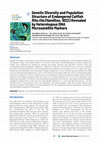
Asian Fisheries Science, 2021
Genetic information is essential for conservation and future aquaculture development of the endan... more Genetic information is essential for conservation and future aquaculture development of the endangered catfish Rita rita (Hamilton, 1822). Two hundred catfish, R. rita, 50 from four rivers, the Old Brahmaputra, Jamuna, Meghna and Kangsa were collected and analysed to evaluate the genetic diversity and population structure using five microsatellite primers (Cba06-KUL, Cba08-KUL, Cba09-KUL, Phy03-KUL and Phy07-KUL). Four of the five amplified loci were found polymorphic (P95) in all the populations and 46 alleles were recorded with 9 to 14 alleles per locus. Differences were observed in the total number of alleles ranging from 41 to 44, effective number of alleles from 29.96 to 37.46, observed heterozygosity from 0.57 to 0.76, Shannon’s information index from 2.09 to 2.30 and polymorphic information content from 0.84 to 0.88 among the four populations. Results exposed the highest levels of genetic diversity in the Meghna population while the lowest in the Kangsa population of R. rita....
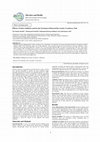
Microbes and Health, 2014
Naturally diseased climbing perch Anabas testudineus was confirmed to be caused by Aeromonas hydr... more Naturally diseased climbing perch Anabas testudineus was confirmed to be caused by Aeromonas hydrophila bacteria by aeromonas isolation medium (AIM), 0/129 vibriostatic agent and esculin hydrolysis. Such naturally diseased koi fish weretreated with four antibiotics: captor (chlortetracycline hydrochloride BP 45%), renamox 15% -Vet (amoxicillin trihydrate BP), oxy-Dox-F (oxytetracycline 20% and + doxycycline 10%), renaquine 20% -Vet (flumequine) at lower, recommended and higher doses were performed to examine the efficacy of the drugs. Captor was given at doses of 0.8, 1.0 and 1.2 g/3 litres of water separately. Doses of renamox 15% -Vet were given at 0.8, 1.0 and 1.2 g/litre of water. Doses of oxy-Dox-F were 0.8, 1.0 and 1.5 g/Kg body weight and doses of renaquine were 10, 12, and 15 mg/Kg body weight. Among the four antibiotics, effect of captor and renaquine at recommended dose showed the best result where 100% fish were recovered. However, renamox and oxy-Dox-F showed best result...
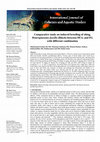
Induced breeding of shing, Heteropneustes fossilis (Bloch, 1794) was carried out by using pituita... more Induced breeding of shing, Heteropneustes fossilis (Bloch, 1794) was carried out by using pituitary gland (PG) and human chorionic gonadotropin (HCG). Twenty pairs of brood fishes were reared up to maturation for spawning operation in a fish farm by providing farm-made artificial diet containing 30% protein for 4-5 months before onset of breeding season. The breeders were induced with hormone HCG (Male 1250 IU/kg and female 2000 IU/kg), PG (Male 10 mg/kg and female 70 mg/kg), HCG 1250 IU/kg for male and PG 70 mg/kg for female, PG 10 mg/kg for male and HCG 2000 IU/kg for female for treatments T1, T2, T3 and T4, respectively. The brood fishes were injected with a single dose. When the brood fishes were injected with HCG the breeding behavior was exhibited quickly and perhaps males lost most of their milt before the ovulation of female and resulting less fertilization rate (84%) in T1. Whereas, the male and female fishes were injected with PG the eggs and milt released at the contemporary times, resulting highest fertilization rate (95%) in T2. In other combination there was some variation of synchronization of releasing eggs and milt. Fertilization rate was 84%, 95%, 80% and 89% and hatching rate was 81.40%, 93%, 89% and 68.90% in treatments T1, T2, T3 and T4, respectively. The incubation periods for fertilized eggs were 22-24 hrs in all treatments. Higher fertilization rate (95%) and hatching rate (93%) were found in case of PG-PG combinations in T2. For induced breeding of H. fossilis a dose of PG 10 mg/kg body weight of male and 70 mg/kg body weight of female in T2 was found to be most effective among the combinations of hormones used.
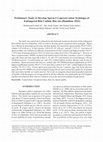
JOURNAL OF FISHERIES AND ENVIRONMENT, Dec 21, 2023
The study was carried out to characterize the fresh and cryopreserved sperm of the endangered
Rit... more The study was carried out to characterize the fresh and cryopreserved sperm of the endangered
Rita catfish, Rita rita (Hamilton, 1822) in order to develop sperm cryopreservation technique. Sperm
was collected by dissecting out the testes and their quality was assessed as sperm motility 96.63±3.03%,
volume 2.87±0.08 μL∙g-1 of fish, density 3.89±0.55×109
cells∙mL-1 and pH 7.73±0.13. Activation of
sperm motility was evaluated in different concentrations of NaCl solution and highest motility (96.67±
1.53%) and swimming duration (70.0±2.0 min) were achieved at 0.4% (128 mmol∙kg-1). Toxicity of
three cryoprotectants- DMSO, methanol and ethanol mixed with three extenders, Alsever’s solution,
egg-yolk citrate and urea egg-yolk at their 5, 10, and 15% concentration was tested during 5–40 min
incubation period. Cryoprotectants at 5 and 10% yielded highest motility during 5 and 10 min of
incubation. Sperm processed with Alsever’s solution plus 10% DMSO produced significantly (p<0.05)
highest equilibration motility (89.67±5.51%) and when cooled at 10 o
C∙min-1 yielded highest post-thaw
motility (79.33±5.13%). Frozen sperm processed with Alsever’s solution, egg-yolk citrate and urea
egg-yolk and 10% DMSO was stored in liquid nitrogen Dewar and assessed their quality by examining
their post-thaw motility at weekly interval. Six-week investigation demonstrated gradual reduction
of motility with the progress of storage period in all three diluents, but significantly (p<0.05) highest
motility was observed from Alsever’s solution even at the end of investigated storage period.
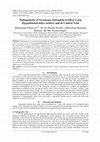
IOSR Journal of Agriculture and Veterinary Science, 2014
Pathogenicity of Aeromonas hydrophila, previously isolated from kidney of apparently healthy silv... more Pathogenicity of Aeromonas hydrophila, previously isolated from kidney of apparently healthy silver carp, was tested in silver carp Hypophthalmichthys molitrix. Trials were also made to control the pathogen in the experimentally infected fish. Before artificial infection the morphological, biochemical and physiological characters of A. hydrophila were studied. The infection was done by intramuscular (IM) injection method. Two different doses viz., 2.8 × 10 5 and 2.8 × 10 6 CFU/fish were used. In all the injected fish external pathology appeared. Reddish lesions on anal region and fin bases were observed. Injected A. hydrophila was re-isolated from liver, kidney and intestine of the challenged fish. It was understood that the isolate was highly virulent pathogen for silver carp. To control the infection by antibiotics, oxysentin 20% (oxytetracyline HCL BP), acimox (amoxicillin trihydrate BP) and oxy-D Vet (oxytetracycline 20% and + doxycycline 10%) were tested at lower, recommended and higher doses of the pharmaceutical companies, respectively. The antibiotic treatments were conducted for 10 days and the fish were observed for 15 days. Among the three antibiotics, acimox and oxy-D Vet at recommended dose showed the best result where 100% fish were recovered. But, oxysentin 20% at higher dose showed best results.
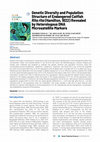
Asian Fisheries Society, 2021
Genetic information is essential for conservation and future aquaculture development of the endan... more Genetic information is essential for conservation and future aquaculture development of the endangered catfish Rita rita (Hamilton, 1822). Two hundred catfish, R. rita, 50 from four rivers, the Old Brahmaputra, Jamuna, Meghna and Kangsa were collected and analysed to evaluate the genetic diversity and population structure using five microsatellite primers (Cba06-KUL, Cba08-KUL, Cba09-KUL, Phy03-KUL and Phy07-KUL). Four of the five amplified loci were found polymorphic (P95) in all the populations and 46 alleles were recorded with 9 to 14 alleles per locus. Differences were observed in the total number of alleles ranging from 41 to 44, effective number of alleles from 29.96 to 37.46, observed heterozygosity from 0.57 to 0.76, Shannon’s information index from 2.09 to 2.30 and polymorphic information content from 0.84 to 0.88 among the four populations. Results exposed the highest levels of genetic diversity in the Meghna population while the lowest in the Kangsa population of R. rita. All the populations were significantly deviated (P < 0.001) from the Hardy-Weinberg equilibrium for all the loci. Nei’s genetic distance between populations ranged 0.007 to 0.017 with low overall genetic difference FST = 0.011 and high gene flow Nm = 24.333, indicating that R. rita populations were not subdivided. This study revealed a high level of gene diversity with deficiency in genetic heterogeneity in all the populations of R. rita, emphasising natural management, conservation and rehabilitation measures of this species.
Commercially important 14 cultured and most popular illustrated in this review paper. Although aq... more Commercially important 14 cultured and most popular illustrated in this review paper. Although aquarium owners keep many other ornamental fishes most of them are close relatives or varieties or strains of the discussed aquarium species. For this, it would not be a problem for a person to identify them who is properly acquainted discussed. Scientific name explanations and the account of geographical locations will help concerned fish species. Fisheries scientists will find very useful information from this
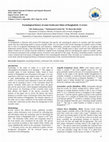
International Journal of Fisheries and Aquatic Research, 2017
As Bangladesh is endowed with around 250 freshwater fish species, the etymological analysis of cu... more As Bangladesh is endowed with around 250 freshwater fish species, the etymological analysis of currently used fish scientific names may have interesting motifs in various scientific fields. It is very hard to find out the meanings of scientific names of fishes due to lack of recognized identifying books and literatures. Additionally, systematic nomenclature will be not recognized and understood without having a clear knowledge about the origin of a word. Though some of these words have been deformed and almost of them are far variants from the standard or original forms, etymology used for elucidating the origin of scientific names. Of all species presented in the available sources, 64 species were selected for this study. All names, including scientific (Greek and Latin), common and local names in Bengali dialects were etymologically analyzed. Thus, the study was considered one of the first works deals with the background history of binomial nomenclature of the concerned freshwater fish species. Introduction Etymology is the study of origin of a word and the chronological development of its meaning [1]. The origins of scientific name of some freshwater fishes, found in local markets of Bangladesh were illustrated in this paper. It is very important to learn how to get original sense of a word in order to gain understanding and put concepts into the proper context. It is obviously more important to know the scientific name and its meaning to have a clear conception about the species. Scientific names have two distinct parts, the genus part and the species part, which designed outstanding identity of the species. So, Etymology of fish's scientific name could help identify and dignify of the species concerned. The purpose of this paper was to review the history and recent progress in scientific name of freshwater fishes often found in internal fish markets of Bangladesh. The ultimate objective of the study was to create a platform for the readers and students so that they could form an idea about the background of fish scientific name.
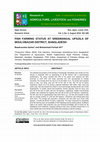
Research in Agriculture, Livestock and Fisheries , 2016
The potential and prospect of fish farming of Sreemangal, Moulvibazar was carried out from Januar... more The potential and prospect of fish farming of Sreemangal, Moulvibazar was carried out from January to December 2015 by interviewing of 90 fish farmers with a well-structured questionnaire. The survey revealed that 40% of the ponds were seasonal and 60% perennial, of which 85% with single ownership and 15% accompanied by multiple ownership. The average pond size was 0.13 ha and depth 2.6 m. The ponds were prepared using of lime, cow dung, urea and TSP at the rate of 250, 250, 40 and 20 kg/ha, respectively. Nearly all of the farmers practiced polyculture with Indian major carps and exotic carps. Fish was stocked from March to June and average stocking density was 15,500 fingerlings/ha. To sustain natural food production, farmers generally used cow dung, urea and TSP at the rate of 2,600, 300 and 150 kg/ha/yr, respectively. Healthy environmental condition was maintained by applying lime and salt at 600 and 60 kg/ha/yr, respectively. The fish were fed by supplementary feed (45% farm) e.g., rice bran and mustard oil-cake with an average quantity of 2,200 and 550 kg/ha/yr, respectively and artificial pellet feed (55% farm). The average fish production, production cost and profit were found 2,945 kg/ha/yr, 1,25,940 and 94,935 Tk./ha/yr, respectively. The major constraints for sustainable pond fish farming were non-availability of fish fingerlings during stocking period, insufficient water in dry season, high production cost, poor technical knowledge, lack of money etc. By establishing more hatcheries, arranging training at farm level, providing interest free or at lower interest loan to the farmers the existing fish production could be increased. To cite this article: Sarker B and MF Ali, 2016. Fish farming status at Sreemangal upazila of Moulvibazar district, Bangladesh. Res. Agric. Livest. Fish., 3 (2): 361-368.
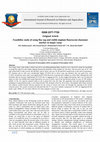
International Journal of Research in Fisheries and Aquaculture, 2015
Two major carps, rohu (Labeo rohita) and silver carp (Hypophthalmichthys molitrix) were selected ... more Two major carps, rohu (Labeo rohita) and silver carp (Hypophthalmichthys molitrix) were selected to study the feasibility of using floy tag (FT) and visible implant fluorescent elastomer (VIE) marker for 120 days. The recovery rate of FT, VIE and control fish of rohu was 82, 86 and 90%, and of silver carp was 76, 80 and 82% respectively at the end of experiment. FT retention rate in rohu was considerably higher (75.6%), but in silver carp, tag retention rate was quite low, only 21.05%. In both the cases, there was significant (P<0.05) decrease in growth rate compare to control fish, although the total mortality did not increase significantly (P>0.05) due to tagging process. In floy-tagged fish group, there was no physical injury in rohu, but reddish and round depression was seen in silver carp in the tag insertion point. In case of VIE marker, neither of the two species retained mark at all in pond trial over the time. By aquarium trial and through periodical sampling in experimental ponds, it was observed that VIE retained at best for 20-25 days. The pliable solid colour inserted into adipose eyelids became discrete particles by the action of mucus and came out through the opening of the needle insertion point. The results of pond trial indicated that the FT was more suitable comparative to VIE, for tagging both the major carps. While, FT was more effective for rohu compare to silver carp.
University Journal of Zoology, Rajshahi University, 2003
Samples of macrobenthic organisms were collected fortnightly from a post harvest rice field in Ba... more Samples of macrobenthic organisms were collected fortnightly from a post harvest rice field in Bangladesh Agricultural University campus, Mymensingh during September to November 2001. Total number of macrobenthic organisms recorded from post harvest rice field was 12,192/m2 with highest number (332/m2) found during 2nd fortnight of September and lowest number (210m2) during the end of November. The macrobenthic organisms consisted of Oligochaeta, Chironomidae and Mullusca. Oligochaeta was represented by Branchiura sowerbyi, Tubifex sp., Aeolosoma sp. and Chaetogaster sp. Chironomidae by Chironomus sp., Procladius sp., Tenypus sp. and Mulluscs by Viviparus bengalensis, Lymnaea sp., Lyrogyrus sp., Tryonia sp. and Planorbis sp.
A study was undertaken to develop the economic status rural women of Kishoregonj district in Bang... more A study was undertaken to develop the economic status rural women of Kishoregonj district in Bangladesh through fish farming.

Indian major carp, Cirrhinus cirrhosus was considered to monitor culture and health status in far... more Indian major carp, Cirrhinus cirrhosus was considered to monitor culture and health status in farm condition from
Bhaluka and Muktagacha of Mymensingh region of Bangladesh for a period of seven months starting from
September, 2010 to March, 2011. Monthly sampling was carried out for growth and health condition. Samples of skin
and muscle, gill, liver and kidney were observed by clinical and histological techniques. Water temperature was at
unfavorable levels but, dissolved oxygen, pH, alkalinity, ammonia and nitrite of water were within the favorable range
for fish culture during the months of December and January. Clinically weak body, rough skin, scale loss, thick gill
filaments, ulcer and gray brownish color were observed. Among the affected fish organs like skin, muscle and gill
were found to be more affected than those of the internal organs, liver and kidney. Major pathologies in the skin and
muscle were loss of epidermis and dermis, presence of fungal granuloma, fungal hyphae, necrosis, hemorrhages,
vacuums and melanocytes. Protozoan cysts, clubbing, hemorrhages, necrosis and hypertrophy were found in the gill.
Necrosis, hemorrhage, pyknosis and vacuums were observed in liver. Common pathological signs like necrosis,
hemorrhage, pyknosis, vacuums and degenerated kidney tubules were noticed in kidney. Overall, in the clinical and
histopathological studies fishes were found to be more affected during the colder months i.e., December and
January. Whereas, in the month of February the pathological condition of fish gradually started to heal up. In
histopathological observation, fishes of Bhaluka farms were more affected than that of Muktagacha fish farms.
Epizootic ulcerative syndrome (EUS) and protozoan diseases were noticed in Bhaluka fish farms.
Keywords: Cirrhinus cirrhosus, Clinical and Pathological condition

The pathogenic bacteria, Aeromonas hydrophila from naturally infected silver carp, Hypophthalmic... more The pathogenic bacteria, Aeromonas hydrophila from naturally infected silver carp, Hypophthalmichthys molitrix were
isolated and identified from a fish farm in Mymensingh. Fish showed motile Aeromonas septicemia (MAS) like reddish
head and anal region, pale body colour and external haemorrhages. Intestine, liver, kidney and environmental
samples such as sediment, feed and water were inoculated onto the Aeromonas isolation medium (AIM) and TSA
plates. The AIM colonies were undergone specific characterization for Aeromonas hydrophila. Quantitative studies of
bacterial flora of fish on TSA plates showed that the total bacterial load in intestine, liver and kidney of the sampled
fish, sediment, feed and water of the environment were 1.00 × 105 to 1.50 × 105 CFU/g, 2.7 × 102 to 4.46 × 104
CFU/g, 1.00 × 103 to 2.17 × 103 CFU/g, 1.90 × 104 CFU/g, 4.10 × 103 CFU/g and 2.50 × 103 CFU/ml, respectively.
After isolation, A. hydrophila was finally identified by their specific morphological, physiological and biochemical
characteristics. They were gram negative, rod shaped, motile bacteria that showed positive reaction for oxidase and
catalase, fermented glucose and were resistant to vibriostatic agent 0/129. They showed positive result in esculin
hydrolysis test.
Keywords: Aeromonas hydrophila, Silver carp, Hypophthalmichthys molitrix, MAS
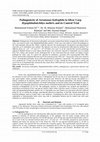
Abstract: Pathogenicity of Aeromonas hydrophila, previously isolated from kidney of apparently he... more Abstract: Pathogenicity of Aeromonas hydrophila, previously isolated from kidney of apparently healthy silver carp, was tested in silver carp Hypophthalmichthys molitrix. Trials were also made to control the pathogen in the experimentally infected fish. Before artificial infection the morphological, biochemical and physiological characters of A. hydrophila were studied. The infection was done by intramuscular (IM) injection method. Two different doses viz., 2.8 × 105 and 2.8 × 106 CFU/fish were used. In all the injected fish external pathology appeared. Reddish lesions on anal region and fin bases were observed. Injected A. hydrophila was re-isolated from liver, kidney and intestine of the challenged fish. It was understood that the isolate was highly virulent pathogen for silver carp. To control the infection by antibiotics, oxysentin 20% (oxytetracyline HCL BP), acimox (amoxicillin trihydrate BP) and oxy-D Vet (oxytetracycline 20% and + doxycycline 10%) were tested at lower, recommended and higher doses of the pharmaceutical companies, respectively. The antibiotic treatments were conducted for 10 days and the fish were observed for 15 days. Among the three antibiotics, acimox and oxy-D Vet at recommended dose showed the best result where 100% fish were recovered. But, oxysentin 20% at higher dose showed best results.
Key words: Aeromonas hydrophila, Hypophthalmichthys molitrix, pathogenicity, experimental infection and antibiotics.
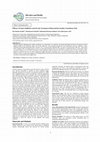
ABSTRACT
Naturally diseased climbing perch Anabas testudineus was confirmed to be caused by Aerom... more ABSTRACT
Naturally diseased climbing perch Anabas testudineus was confirmed to be caused by Aeromonas hydrophila bacteria by aeromonas isolation medium (AIM), 0/129 vibriostatic agent and esculin hydrolysis. Such naturally diseased koi fish weretreated with four antibiotics: captor (chlortetracycline hydrochloride BP 45%), renamox 15% -Vet (amoxicillin trihydrate BP), oxy-Dox-F (oxytetracycline 20% and + doxycycline 10%), renaquine 20% -Vet (flumequine) at lower, recommended and higher doses were performed to examine the efficacy of the drugs. Captor was given at doses of 0.8, 1.0 and 1.2 g/3 litres of water separately. Doses of renamox 15% -Vet were given at 0.8, 1.0 and 1.2 g/litre of water. Doses of oxy-Dox-F were 0.8, 1.0 and 1.5 g/Kg body weight and doses of renaquine were 10, 12, and 15 mg/Kg body weight. Among the four antibiotics, effect of captor and renaquine at recommended dose showed the best result where 100% fish were recovered. However, renamox and oxy-Dox-F showed best result at higher dose.
Key Words: Climbing perch, Anabas testudineus, Antibiotics.
Received: 10th February, 2014. Accepted: 7th July 2014.
©2014 Microbes and Health. All rights reserved
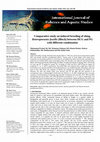
Abstract
Induced breeding of shing, Heteropneustes fossilis (Bloch, 1794) was carried out by usin... more Abstract
Induced breeding of shing, Heteropneustes fossilis (Bloch, 1794) was carried out by using pituitary gland
(PG) and human chorionic gonadotropin (HCG). Twenty pairs of brood fishes were reared up to
maturation for spawning operation in a fish farm by providing farm-made artificial diet containing 30%
protein for 4-5 months before onset of breeding season. The breeders were induced with hormone HCG
(Male 1250 IU/kg and female 2000 IU/kg), PG (Male 10 mg/kg and female 70 mg/kg), HCG 1250 IU/kg
for male and PG 70 mg/kg for female, PG 10 mg/kg for male and HCG 2000 IU/kg for female for
treatments T1, T2, T3 and T4, respectively. The brood fishes were injected with a single dose. When the
brood fishes were injected with HCG the breeding behavior was exhibited quickly and perhaps males lost
most of their milt before the ovulation of female and resulting less fertilization rate (84%) in T1.
Whereas, the male and female fishes were injected with PG the eggs and milt released at the
contemporary times, resulting highest fertilization rate (95%) in T2. In other combination there was some
variation of synchronization of releasing eggs and milt. Fertilization rate was 84%, 95%, 80% and 89%
and hatching rate was 81.40%, 93%, 89% and 68.90% in treatments T1, T2, T3 and T4, respectively. The
incubation periods for fertilized eggs were 22-24 hrs in all treatments. Higher fertilization rate (95%) and
hatching rate (93%) were found in case of PG-PG combinations in T2. For induced breeding of H. fossilis
a dose of PG 10 mg/kg body weight of male and 70 mg/kg body weight of female in T2 was found to be
most effective among the combinations of hormones used.
Keywords: Induced breeding, Heteropneustes fossilis, pituitary gland (PG) and human chorionic
gonadotropin (HCG).









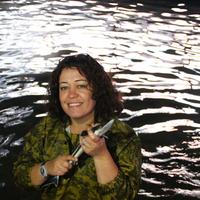
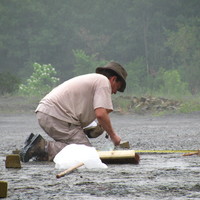
Uploads
Papers by Dr. Muhammad F O R H A D Ali
Rita catfish, Rita rita (Hamilton, 1822) in order to develop sperm cryopreservation technique. Sperm
was collected by dissecting out the testes and their quality was assessed as sperm motility 96.63±3.03%,
volume 2.87±0.08 μL∙g-1 of fish, density 3.89±0.55×109
cells∙mL-1 and pH 7.73±0.13. Activation of
sperm motility was evaluated in different concentrations of NaCl solution and highest motility (96.67±
1.53%) and swimming duration (70.0±2.0 min) were achieved at 0.4% (128 mmol∙kg-1). Toxicity of
three cryoprotectants- DMSO, methanol and ethanol mixed with three extenders, Alsever’s solution,
egg-yolk citrate and urea egg-yolk at their 5, 10, and 15% concentration was tested during 5–40 min
incubation period. Cryoprotectants at 5 and 10% yielded highest motility during 5 and 10 min of
incubation. Sperm processed with Alsever’s solution plus 10% DMSO produced significantly (p<0.05)
highest equilibration motility (89.67±5.51%) and when cooled at 10 o
C∙min-1 yielded highest post-thaw
motility (79.33±5.13%). Frozen sperm processed with Alsever’s solution, egg-yolk citrate and urea
egg-yolk and 10% DMSO was stored in liquid nitrogen Dewar and assessed their quality by examining
their post-thaw motility at weekly interval. Six-week investigation demonstrated gradual reduction
of motility with the progress of storage period in all three diluents, but significantly (p<0.05) highest
motility was observed from Alsever’s solution even at the end of investigated storage period.
Bhaluka and Muktagacha of Mymensingh region of Bangladesh for a period of seven months starting from
September, 2010 to March, 2011. Monthly sampling was carried out for growth and health condition. Samples of skin
and muscle, gill, liver and kidney were observed by clinical and histological techniques. Water temperature was at
unfavorable levels but, dissolved oxygen, pH, alkalinity, ammonia and nitrite of water were within the favorable range
for fish culture during the months of December and January. Clinically weak body, rough skin, scale loss, thick gill
filaments, ulcer and gray brownish color were observed. Among the affected fish organs like skin, muscle and gill
were found to be more affected than those of the internal organs, liver and kidney. Major pathologies in the skin and
muscle were loss of epidermis and dermis, presence of fungal granuloma, fungal hyphae, necrosis, hemorrhages,
vacuums and melanocytes. Protozoan cysts, clubbing, hemorrhages, necrosis and hypertrophy were found in the gill.
Necrosis, hemorrhage, pyknosis and vacuums were observed in liver. Common pathological signs like necrosis,
hemorrhage, pyknosis, vacuums and degenerated kidney tubules were noticed in kidney. Overall, in the clinical and
histopathological studies fishes were found to be more affected during the colder months i.e., December and
January. Whereas, in the month of February the pathological condition of fish gradually started to heal up. In
histopathological observation, fishes of Bhaluka farms were more affected than that of Muktagacha fish farms.
Epizootic ulcerative syndrome (EUS) and protozoan diseases were noticed in Bhaluka fish farms.
Keywords: Cirrhinus cirrhosus, Clinical and Pathological condition
isolated and identified from a fish farm in Mymensingh. Fish showed motile Aeromonas septicemia (MAS) like reddish
head and anal region, pale body colour and external haemorrhages. Intestine, liver, kidney and environmental
samples such as sediment, feed and water were inoculated onto the Aeromonas isolation medium (AIM) and TSA
plates. The AIM colonies were undergone specific characterization for Aeromonas hydrophila. Quantitative studies of
bacterial flora of fish on TSA plates showed that the total bacterial load in intestine, liver and kidney of the sampled
fish, sediment, feed and water of the environment were 1.00 × 105 to 1.50 × 105 CFU/g, 2.7 × 102 to 4.46 × 104
CFU/g, 1.00 × 103 to 2.17 × 103 CFU/g, 1.90 × 104 CFU/g, 4.10 × 103 CFU/g and 2.50 × 103 CFU/ml, respectively.
After isolation, A. hydrophila was finally identified by their specific morphological, physiological and biochemical
characteristics. They were gram negative, rod shaped, motile bacteria that showed positive reaction for oxidase and
catalase, fermented glucose and were resistant to vibriostatic agent 0/129. They showed positive result in esculin
hydrolysis test.
Keywords: Aeromonas hydrophila, Silver carp, Hypophthalmichthys molitrix, MAS
Key words: Aeromonas hydrophila, Hypophthalmichthys molitrix, pathogenicity, experimental infection and antibiotics.
Naturally diseased climbing perch Anabas testudineus was confirmed to be caused by Aeromonas hydrophila bacteria by aeromonas isolation medium (AIM), 0/129 vibriostatic agent and esculin hydrolysis. Such naturally diseased koi fish weretreated with four antibiotics: captor (chlortetracycline hydrochloride BP 45%), renamox 15% -Vet (amoxicillin trihydrate BP), oxy-Dox-F (oxytetracycline 20% and + doxycycline 10%), renaquine 20% -Vet (flumequine) at lower, recommended and higher doses were performed to examine the efficacy of the drugs. Captor was given at doses of 0.8, 1.0 and 1.2 g/3 litres of water separately. Doses of renamox 15% -Vet were given at 0.8, 1.0 and 1.2 g/litre of water. Doses of oxy-Dox-F were 0.8, 1.0 and 1.5 g/Kg body weight and doses of renaquine were 10, 12, and 15 mg/Kg body weight. Among the four antibiotics, effect of captor and renaquine at recommended dose showed the best result where 100% fish were recovered. However, renamox and oxy-Dox-F showed best result at higher dose.
Key Words: Climbing perch, Anabas testudineus, Antibiotics.
Received: 10th February, 2014. Accepted: 7th July 2014.
©2014 Microbes and Health. All rights reserved
Induced breeding of shing, Heteropneustes fossilis (Bloch, 1794) was carried out by using pituitary gland
(PG) and human chorionic gonadotropin (HCG). Twenty pairs of brood fishes were reared up to
maturation for spawning operation in a fish farm by providing farm-made artificial diet containing 30%
protein for 4-5 months before onset of breeding season. The breeders were induced with hormone HCG
(Male 1250 IU/kg and female 2000 IU/kg), PG (Male 10 mg/kg and female 70 mg/kg), HCG 1250 IU/kg
for male and PG 70 mg/kg for female, PG 10 mg/kg for male and HCG 2000 IU/kg for female for
treatments T1, T2, T3 and T4, respectively. The brood fishes were injected with a single dose. When the
brood fishes were injected with HCG the breeding behavior was exhibited quickly and perhaps males lost
most of their milt before the ovulation of female and resulting less fertilization rate (84%) in T1.
Whereas, the male and female fishes were injected with PG the eggs and milt released at the
contemporary times, resulting highest fertilization rate (95%) in T2. In other combination there was some
variation of synchronization of releasing eggs and milt. Fertilization rate was 84%, 95%, 80% and 89%
and hatching rate was 81.40%, 93%, 89% and 68.90% in treatments T1, T2, T3 and T4, respectively. The
incubation periods for fertilized eggs were 22-24 hrs in all treatments. Higher fertilization rate (95%) and
hatching rate (93%) were found in case of PG-PG combinations in T2. For induced breeding of H. fossilis
a dose of PG 10 mg/kg body weight of male and 70 mg/kg body weight of female in T2 was found to be
most effective among the combinations of hormones used.
Keywords: Induced breeding, Heteropneustes fossilis, pituitary gland (PG) and human chorionic
gonadotropin (HCG).
Rita catfish, Rita rita (Hamilton, 1822) in order to develop sperm cryopreservation technique. Sperm
was collected by dissecting out the testes and their quality was assessed as sperm motility 96.63±3.03%,
volume 2.87±0.08 μL∙g-1 of fish, density 3.89±0.55×109
cells∙mL-1 and pH 7.73±0.13. Activation of
sperm motility was evaluated in different concentrations of NaCl solution and highest motility (96.67±
1.53%) and swimming duration (70.0±2.0 min) were achieved at 0.4% (128 mmol∙kg-1). Toxicity of
three cryoprotectants- DMSO, methanol and ethanol mixed with three extenders, Alsever’s solution,
egg-yolk citrate and urea egg-yolk at their 5, 10, and 15% concentration was tested during 5–40 min
incubation period. Cryoprotectants at 5 and 10% yielded highest motility during 5 and 10 min of
incubation. Sperm processed with Alsever’s solution plus 10% DMSO produced significantly (p<0.05)
highest equilibration motility (89.67±5.51%) and when cooled at 10 o
C∙min-1 yielded highest post-thaw
motility (79.33±5.13%). Frozen sperm processed with Alsever’s solution, egg-yolk citrate and urea
egg-yolk and 10% DMSO was stored in liquid nitrogen Dewar and assessed their quality by examining
their post-thaw motility at weekly interval. Six-week investigation demonstrated gradual reduction
of motility with the progress of storage period in all three diluents, but significantly (p<0.05) highest
motility was observed from Alsever’s solution even at the end of investigated storage period.
Bhaluka and Muktagacha of Mymensingh region of Bangladesh for a period of seven months starting from
September, 2010 to March, 2011. Monthly sampling was carried out for growth and health condition. Samples of skin
and muscle, gill, liver and kidney were observed by clinical and histological techniques. Water temperature was at
unfavorable levels but, dissolved oxygen, pH, alkalinity, ammonia and nitrite of water were within the favorable range
for fish culture during the months of December and January. Clinically weak body, rough skin, scale loss, thick gill
filaments, ulcer and gray brownish color were observed. Among the affected fish organs like skin, muscle and gill
were found to be more affected than those of the internal organs, liver and kidney. Major pathologies in the skin and
muscle were loss of epidermis and dermis, presence of fungal granuloma, fungal hyphae, necrosis, hemorrhages,
vacuums and melanocytes. Protozoan cysts, clubbing, hemorrhages, necrosis and hypertrophy were found in the gill.
Necrosis, hemorrhage, pyknosis and vacuums were observed in liver. Common pathological signs like necrosis,
hemorrhage, pyknosis, vacuums and degenerated kidney tubules were noticed in kidney. Overall, in the clinical and
histopathological studies fishes were found to be more affected during the colder months i.e., December and
January. Whereas, in the month of February the pathological condition of fish gradually started to heal up. In
histopathological observation, fishes of Bhaluka farms were more affected than that of Muktagacha fish farms.
Epizootic ulcerative syndrome (EUS) and protozoan diseases were noticed in Bhaluka fish farms.
Keywords: Cirrhinus cirrhosus, Clinical and Pathological condition
isolated and identified from a fish farm in Mymensingh. Fish showed motile Aeromonas septicemia (MAS) like reddish
head and anal region, pale body colour and external haemorrhages. Intestine, liver, kidney and environmental
samples such as sediment, feed and water were inoculated onto the Aeromonas isolation medium (AIM) and TSA
plates. The AIM colonies were undergone specific characterization for Aeromonas hydrophila. Quantitative studies of
bacterial flora of fish on TSA plates showed that the total bacterial load in intestine, liver and kidney of the sampled
fish, sediment, feed and water of the environment were 1.00 × 105 to 1.50 × 105 CFU/g, 2.7 × 102 to 4.46 × 104
CFU/g, 1.00 × 103 to 2.17 × 103 CFU/g, 1.90 × 104 CFU/g, 4.10 × 103 CFU/g and 2.50 × 103 CFU/ml, respectively.
After isolation, A. hydrophila was finally identified by their specific morphological, physiological and biochemical
characteristics. They were gram negative, rod shaped, motile bacteria that showed positive reaction for oxidase and
catalase, fermented glucose and were resistant to vibriostatic agent 0/129. They showed positive result in esculin
hydrolysis test.
Keywords: Aeromonas hydrophila, Silver carp, Hypophthalmichthys molitrix, MAS
Key words: Aeromonas hydrophila, Hypophthalmichthys molitrix, pathogenicity, experimental infection and antibiotics.
Naturally diseased climbing perch Anabas testudineus was confirmed to be caused by Aeromonas hydrophila bacteria by aeromonas isolation medium (AIM), 0/129 vibriostatic agent and esculin hydrolysis. Such naturally diseased koi fish weretreated with four antibiotics: captor (chlortetracycline hydrochloride BP 45%), renamox 15% -Vet (amoxicillin trihydrate BP), oxy-Dox-F (oxytetracycline 20% and + doxycycline 10%), renaquine 20% -Vet (flumequine) at lower, recommended and higher doses were performed to examine the efficacy of the drugs. Captor was given at doses of 0.8, 1.0 and 1.2 g/3 litres of water separately. Doses of renamox 15% -Vet were given at 0.8, 1.0 and 1.2 g/litre of water. Doses of oxy-Dox-F were 0.8, 1.0 and 1.5 g/Kg body weight and doses of renaquine were 10, 12, and 15 mg/Kg body weight. Among the four antibiotics, effect of captor and renaquine at recommended dose showed the best result where 100% fish were recovered. However, renamox and oxy-Dox-F showed best result at higher dose.
Key Words: Climbing perch, Anabas testudineus, Antibiotics.
Received: 10th February, 2014. Accepted: 7th July 2014.
©2014 Microbes and Health. All rights reserved
Induced breeding of shing, Heteropneustes fossilis (Bloch, 1794) was carried out by using pituitary gland
(PG) and human chorionic gonadotropin (HCG). Twenty pairs of brood fishes were reared up to
maturation for spawning operation in a fish farm by providing farm-made artificial diet containing 30%
protein for 4-5 months before onset of breeding season. The breeders were induced with hormone HCG
(Male 1250 IU/kg and female 2000 IU/kg), PG (Male 10 mg/kg and female 70 mg/kg), HCG 1250 IU/kg
for male and PG 70 mg/kg for female, PG 10 mg/kg for male and HCG 2000 IU/kg for female for
treatments T1, T2, T3 and T4, respectively. The brood fishes were injected with a single dose. When the
brood fishes were injected with HCG the breeding behavior was exhibited quickly and perhaps males lost
most of their milt before the ovulation of female and resulting less fertilization rate (84%) in T1.
Whereas, the male and female fishes were injected with PG the eggs and milt released at the
contemporary times, resulting highest fertilization rate (95%) in T2. In other combination there was some
variation of synchronization of releasing eggs and milt. Fertilization rate was 84%, 95%, 80% and 89%
and hatching rate was 81.40%, 93%, 89% and 68.90% in treatments T1, T2, T3 and T4, respectively. The
incubation periods for fertilized eggs were 22-24 hrs in all treatments. Higher fertilization rate (95%) and
hatching rate (93%) were found in case of PG-PG combinations in T2. For induced breeding of H. fossilis
a dose of PG 10 mg/kg body weight of male and 70 mg/kg body weight of female in T2 was found to be
most effective among the combinations of hormones used.
Keywords: Induced breeding, Heteropneustes fossilis, pituitary gland (PG) and human chorionic
gonadotropin (HCG).